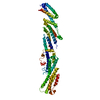+ データを開く
データを開く
- 基本情報
基本情報
| 登録情報 | データベース: SASBDB / ID: SASDBB4 |
|---|---|
 試料 試料 | Plakin domain fragment of Human plectin (C-terminal region spectrin repeats: SR7-SR8-SR9)
|
| 機能・相同性 | Isoform 2 of Plectin 機能・相同性情報 機能・相同性情報 |
| 生物種 |  Homo sapiens (ヒト) Homo sapiens (ヒト) |
 引用 引用 |  ジャーナル: J Biol Chem / 年: 2016 ジャーナル: J Biol Chem / 年: 2016タイトル: The Structure of the Plakin Domain of Plectin Reveals an Extended Rod-like Shape. 著者: Esther Ortega / José A Manso / Rubén M Buey / Ana M Carballido / Arturo Carabias / Arnoud Sonnenberg / José M de Pereda /   要旨: Plakins are large multi-domain proteins that interconnect cytoskeletal structures. Plectin is a prototypical plakin that tethers intermediate filaments to membrane-associated complexes. Most plakins ...Plakins are large multi-domain proteins that interconnect cytoskeletal structures. Plectin is a prototypical plakin that tethers intermediate filaments to membrane-associated complexes. Most plakins contain a plakin domain formed by up to nine spectrin repeats (SR1-SR9) and an SH3 domain. The plakin domains of plectin and other plakins harbor binding sites for junctional proteins. We have combined x-ray crystallography with small angle x-ray scattering (SAXS) to elucidate the structure of the plakin domain of plectin, extending our previous analysis of the SR1 to SR5 region. Two crystal structures of the SR5-SR6 region allowed us to characterize its uniquely wide inter-repeat conformational variability. We also report the crystal structures of the SR7-SR8 region, refined to 1.8 Å, and the SR7-SR9 at lower resolution. The SR7-SR9 region, which is conserved in all other plakin domains, forms a rigid segment stabilized by uniquely extensive inter-repeat contacts mediated by unusually long helices in SR8 and SR9. Using SAXS we show that in solution the SR3-SR6 and SR7-SR9 regions are rod-like segments and that SR3-SR9 of plectin has an extended shape with a small central kink. Other plakins, such as bullous pemphigoid antigen 1 and microtubule and actin cross-linking factor 1, are likely to have similar extended plakin domains. In contrast, desmoplakin has a two-segment structure with a central flexible hinge. The continuous versus segmented structures of the plakin domains of plectin and desmoplakin give insight into how different plakins might respond to tension and transmit mechanical signals. |
 登録者 登録者 |
|
- 構造の表示
構造の表示
| 構造ビューア | 分子:  Molmil Molmil Jmol/JSmol Jmol/JSmol |
|---|
- ダウンロードとリンク
ダウンロードとリンク
-モデル
| モデル #495 |  タイプ: dummy / ソフトウェア: DAMMIF / ダミー原子の半径: 3.60 A / カイ2乗値: 0.955 / P-value: 0.667500  Omokage検索でこの集合体の類似形状データを探す (詳細) Omokage検索でこの集合体の類似形状データを探す (詳細) |
|---|
- 試料
試料
 試料 試料 | 名称: Plakin domain fragment of Human plectin (C-terminal region spectrin repeats: SR7-SR8-SR9) 試料濃度: 1.50-12.30 |
|---|---|
| バッファ | 名称: sodium phosphate / 濃度: 20.00 mM / pH: 7.5 / 組成: 150 mM NaCl, 5% glycerol, 3 mM DTT |
| 要素 #320 | 名称: Plectin / タイプ: protein 記述: Plakin domain fragment of Human plectin encompassing spectrin repeats SR7-SR8-SR9 分子量: 42.825 / 分子数: 1 / 由来: Homo sapiens / 参照: UniProt: Q15149-2 配列: GSHMQEESRC QRCISELKDI RLQLEACETR TVHRLRLPLD KEPARECAQR IAEQQKAQAE VEGLGKGVAR LSAEAEKVLA LPEPSPAAPT LRSELELTLG KLEQVRSLSA IYLEKLKTIS LVIRGTQGAE EVLRAHEEQL KEAQAVPATL PELEATKASL KKLRAQAEAQ ...配列: GSHMQEESRC QRCISELKDI RLQLEACETR TVHRLRLPLD KEPARECAQR IAEQQKAQAE VEGLGKGVAR LSAEAEKVLA LPEPSPAAPT LRSELELTLG KLEQVRSLSA IYLEKLKTIS LVIRGTQGAE EVLRAHEEQL KEAQAVPATL PELEATKASL KKLRAQAEAQ QPTFDALRDE LRGAQEVGER LQQRHGERDV EVERWRERVA QLLERWQAVL AQTDVRQREL EQLGRQLRYY RESADPLGAW LQDARRRQEQ IQAMPLADSQ AVREQLRQEQ ALLEEIERHG EKVEECQRFA KQYINAIKDY ELQLVTYKAQ LEPVASPAKK PKVQSGSESV IQEYVDLRTH YSELTTLTSQ YIKFISETLR RME |
-実験情報
| ビーム | 設備名称: PETRA III P12 / 地域: Hamburg / 国: Germany  / 線源: X-ray synchrotron / 波長: 0.12 Å / スペクトロメータ・検出器間距離: 3.1 mm / 線源: X-ray synchrotron / 波長: 0.12 Å / スペクトロメータ・検出器間距離: 3.1 mm | ||||||||||||||||||
|---|---|---|---|---|---|---|---|---|---|---|---|---|---|---|---|---|---|---|---|
| 検出器 | 名称: Pilatus 2M | ||||||||||||||||||
| スキャン |
| ||||||||||||||||||
| 距離分布関数 P(R) |
| ||||||||||||||||||
| 結果 |
|
 ムービー
ムービー コントローラー
コントローラー


 SASDBB4
SASDBB4

















